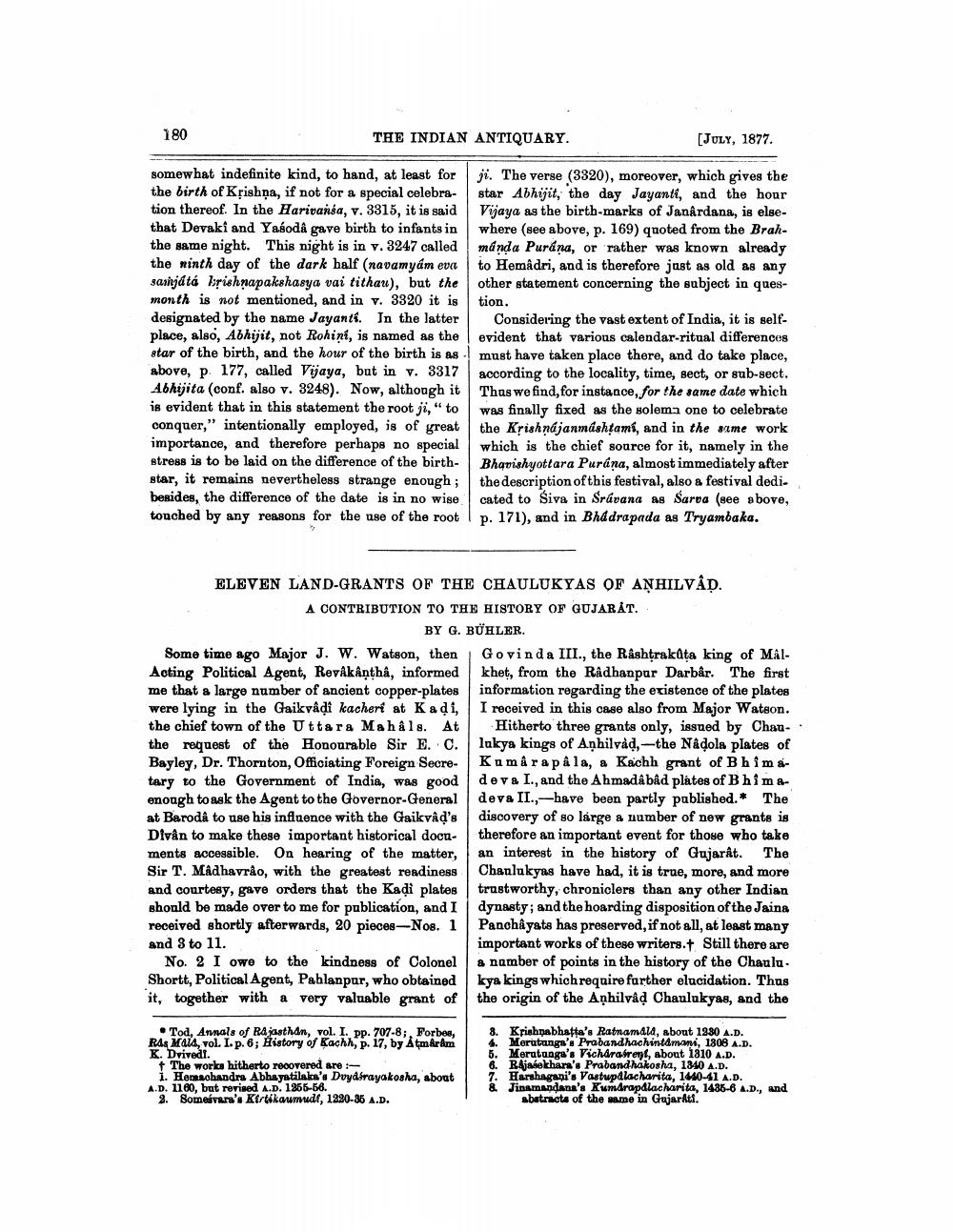________________
180
THE INDIAN ANTIQUARY.
[JULY, 1877.
somewhat indefinite kind, to hand, at least for the birth of Krishna, if not for a special celebra- tion thereof. In the Haritansa, v. 3315, it is said that Devaki and Yasodâ gave birth to infants in the same night. This night is in v. 3247 called the ninth day of the dark half (navamyám eva sanjatá Irishnapakshasya vai tithau), but the month is not mentioned, and in v. 3320 it is designated by the name Jayanti. In the latter place, also, Abhijit, not Rohini, is named as the star of the birth, and the hour of the birth is as above, p. 177, called Vijaya, but in v. 3317 Abhijita (conf. also v. 3248). Now, although it is evident that in this statement the root ji," to conquer," intentionally employed, is of great importance, and therefore perhaps no special stress is to be laid on the difference of the birthstar, it remains nevertheless strange enough; besides, the difference of the date is in no wise touched by any reasons for the use of the root
ji. The verse (3320), moreover, which gives the star Abhijit, the day Jayanti, and the hour Vijaya as the birth-marks of Janârdana, is elsewhere (see above, p. 169) quoted from the Brahmanda Purana, or rather was known already to Hemadri, and is therefore just as old as any other statement concerning the subject in question.
Considering the vast extent of India, it is selfevident that various calendar-ritual differences must have taken place there, and do take place, according to the locality, time, sect, or sub-sect. Thus we find, for instance, for the same date which was finally fixed as the solema one to celebrate the Krishnájanmashtami, and in the same work which is the chief source for it, namely in the Bhavishyottara Purana, almost immediately after the description of this festival, also a festival dedi. cated to Siva in Srávana as Sarva (see above, p. 171), and in Bhadrapada as Tryambaka.
ELEVEN LAND-GRANTS OF THE CHAULUKYAS OF ANHILVÅD. A CONTRIBUTION TO THE HISTORY OF GUJARAT.
BY G. BÜHLER. Some time ago Major J. W. Watson, then Govinda III., the Rashtrakata king of MalActing Political Agent, RevAkantha, informed khet, from the Radhanpur Darbår. The first me that a large number of ancient copper-plates information regarding the existence of the plates were lying in the Gaikyâdi kacheri at Kadi, I received in this case also from Major Watson. the chief town of the Uttara Mahals. At Hitherto three grants only, issued by Chauthe request of the Honourable Sir E. c. lukya kings of Anhilvåd, the Nádola plates of Bayley, Dr. Thornton, Officiating Foreign Secre- Komarapala, a Kachh grant of Bhimatary to the Government of India, was good deva I., and the Ahmadâbâd plates of Bhimaenough to ask the Agent to the Governor-General deva II.,-have been partly pablished.* The at Baroda to use his influence with the Gaikvad's discovery of so large a number of new grants is Divân to make these important historical docn- therefore an important event for those who take ments accessible. On hearing of the matter, an interest in the history of Gujarât. The Sir T. Madhavrào, with the greatest readiness Chanlukyas have had, it is true, more, and more and courtesy, gave orders that the Kadi plates trustworthy, chroniclers than any other Indian shonld be made over to me for publication, and I dynasty; and the hoarding disposition of the Jaina received shortly afterwards, 20 pieces--Nos. 1 Panchayata has preserved, if not all, at least many and 3 to 11.
important works of these writers.t Still there are No. 2 I owe to the kindness of Colonel a namber of points in the history of the Chaulu. Shortt, Political Agent, Pablanpur, who obtained kya kings which require further elucidation. Thus it, together with a very valuable grant of the origin of the Anhilvåd Chaulukyas, and the
• Tod, Annals of Rajasthan, vol. I. pp. 707-8;, Forbes, Ras Mais, vol. I. p. 6; History of Kachh, p. 17, by Atm&ram K. Drivedi.
+ The worka hitherto recovered are:
1. Hemachandra Abhayatilaka's Dvyasrayakosha, about A.D. 1160, but revised A.D. 1956-58.
2. Somesvara's Kirtikaumudi, 1220-36 A.D.
8. Krishnabhatta's Ratnamala, about 1980 A.D. 4. Merutanga's Prabandhachintamani, 1808 A.D. 5. Meratunga's Vicharabrent, about 1310 A.D. 6. R&jasekhara's Prabandhakosha, 1340 A.D. 7. Harshagani's Vastupdlacharita, 1440-41 A.D. & Jinsmandana's Kumdrapdlacharita, 1436-6 A.D., and
sbatracts of the same in Gujarati.




